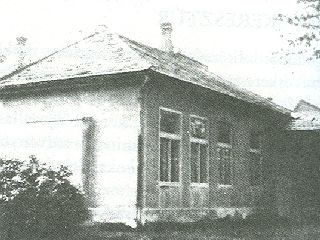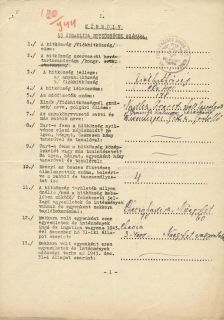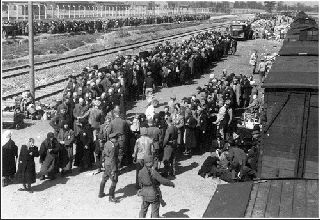A Village: Rákosszentmihály
The village Rákosszentmihály had a small, rural Jewish community prior to the Holocaust. As was the case with all similar communities in Hungary, its members were humiliated, looted, ghettoised and deported in 1944. Although a fragment of the community returned after the liberation, and the congregation reorganized itself, in a few years it ceased to exist. The fate of the Rákosszentmihály Jews is a typical example of the destruction of the countryside Jewry in Hungary.
Click here to read more about the Holocaust in Hungary.
The Jewish community of Rákosszentmihály
Jews were first registered in Rákosszentmihály (2 persons) in the 1840 census, but the institutional Jewish congregation was established only in 1900. The community joined the Neolog branch of Hungarian Jewry. The number of Jews in the village continuously increased until 1930, and then it started to slowly decrease. According to the 1941 census there were 787 religious Jews and 106 converts living in the village. [1] The data from spring 1944 indicate 400 members of the community. The head of
 |
The synagogue of Rákosszentmihály |
Ghettoisation and deportation in the outskirts of Budapest
In 1944 the settlements in the outskirts of Budapest (among them Rákosszentmihály as well) belonged to Gendarmerie District I. The deportation plan elaborated by SS Lieutenant Colonel Adolf Eichmann and State Secretary of the Ministry of the Interior László Endre assigned this region to Deportation Zone VI. Accordingly, they intended to deport the Jews of the capital and the outskirts in the last phase of the process. Deportation Zone VI overlapped the northern part of Pest-Pilis-Solt-Kiskun County. This large administrative unit belonged to two deportation zones (northern: VI, southern: IV), but since the ghettoisation process was directed on the county level, the same decree stipulated the concentration of Jews in the southern and northern region too. As of 1938 the sub-prefect of the county was one of the most prominent antisemitic public figures of Hungary, László Endre. After the German occupation of the country when the collaborating Sztójay-government was set up, Endre became the State Secretary of the Ministry of the Interior. The similarly antisemitic József Sághy became the new sub-prefect and the collaborating government appointed László Mérey the new prefect. The ghettoisation process was not directed by Sághy, but County Chief Notary András Géczy. The ghettoisation of the county's Jewry was ordered by Géczy's decree no. 27.409/1944 on May 12, 1944. [4]
The concentration of the Jews of the capital's outskirts was implemented during May and June. The details of the concentration and deportation were elaborated at a meeting held in the Budapest City Hall on June 28, 1944. The deportation order was communicated to the ghetto commanders only verbally. In the last days of June and the first days of July the region's Jewry was concentrated in the two collecting camps: Monor and Budakalász. From these two brick factories 24,128 Jews were deported to Auschwitz between July 6 and 8. The last trains departed after Regent Horthy halted the deportations on July 6-7. [5]
The destruction of the Rákosszentmihály Jews
In Rákosszentmihály there was no separate ghetto set up surrounded
 |
The data registry sheet of the Rákosszentmihály Jewish community as requested by the Central Jewish Council on order of the Nazis (April 1944) |
The 36-year-old textile shop-owner had no idea that this attitude was far from the general behaviour of the gendarmerie. However in the Budakalász brick factory it became evident desperately soon. The gendarme unit from Debrecen consisting of 50 men, led by Major Almássy (or Almási) and the SS unit of 10 men treated the prisoners brutally; murders even occurred. The gendarmes focused their "investigations" on hidden valuables; they tortured the Jews, most of whom suffered in the brick factory without food or shelter, deprived of basic hygienic means. This is how a teacher from
 |
Selection of Hungarian Jews in Auschwitz-Birkenau |
Thousands of Gentiles commuting between the outskirts and the capital saw the
Words of the survivors - link centerThe gendarmes robbed us of everything Seventy-two of us were squeezed into one cattle car |
The Jews of Rákosszentmihály were also deported to Auschwitz. The Klein sisters last saw their parents on the ramp in Birkenau: "we were immediately separated from our parents. We have not heard about them ever since; then we had no idea what happened to them, but now we know." [9] The selecting SS-physicians found them capable of working and therefore allowed them to live. Later they were taken to an ammunition factory where they performed slave labour for the Nazis. The mother of the aforementioned Erzsébet Büchler was immediately sent to the gas camber too. She managed to stay together with her sister. Later they were deported to Bergen-Belsen where her sister, Erzsébet, fell ill and died.
Approximately 120 survivors returned to Rákosszentmihály. [10]
Footnotes
[1] Kepes 1993, pp. 226-227.
[2] Frojimovics - Schweitzer 1994, pp. 572-273.
[3] Protocol 1866
[4] Braham 2007, p. 811.
[5] Braham 1997, p. 741.
[6] Protocol 1747
[7] Protocol 3328
[8] Protocol 3645
[9] Protocol 2548
[10] Braham 2007, p. 877.
References
Braham 1997
Randolph L. Braham: A népirtás politikája - a Holocaust Magyarországon. (The Politics of Genocide. The Holocaust in Hungary.) Vols. 1-2. Budapest, 1997, Belvárosi Könyvkiadó.
Braham 2007
Randolph L. Braham (ed.): A magyarországi holokauszt földrajzi enciklopédiája. (The Geographic Encyclopaedia of the Holocaust in Hungary) Vols. 1-3- Budapest, 2007, Park.
Frojimovics - Schweitzer 1994
Frojimovics Kinga - Schweitzer József (eds.): Magyarországi Zsidó Hitközségek 1944 április. A Magyar Zsidók Központi Tanácsának összeírása a német hatóságok rendelkezése nyomán. (Jewish Communities of Hungary in April 1944. The Survey Conducted by the Central Council of Hungarian Jews as Ordered by the German Authorities) Budapest, 1994, MTA Judaisztikai Kutatócsport - Magyar Zsidó Levéltár - Országos Rabbiképző Intézet.
Kepes 1993
Kepes József (ed.): A zsidó népesség száma településenként (1840-1941) (Number of Jews by Settlements 1840-1941). Budapest, 1993, Központi Statisztikai Hivatal.

